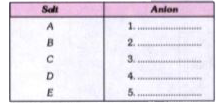When dilute nitric acid is added to copper turning, the gas evolved is
NO
N2O
NO2
H2
The correct Answer is:A
To determine the gas evolved when dilute nitric acid is added to copper turnings, we can follow these steps:
1. Identify the Reactants:
- The reactants in this reaction are copper (Cu) and dilute nitric acid (HNO3).
2. Write the Chemical Reaction:
- When copper reacts with dilute nitric acid, the products formed are copper(II) nitrate (Cu(NO3)2), nitrogen dioxide (NO2), and water (H2O).
- The unbalanced reaction can be written as:
Cu+HNO3→Cu(NO3)2+NO2+H2O
3. Balance the Chemical Equation:
- To balance the equation, we need to ensure that the number of atoms for each element is the same on both sides. The balanced equation is:
4HNO3+Cu→2NO2+2H2O+Cu(NO3)2
4. Identify the Gas Evolved:
- From the balanced equation, we can see that nitrogen dioxide (NO2) is one of the products formed in the reaction.
- Therefore, when dilute nitric acid is added to copper turnings, the gas evolved is nitrogen dioxide (NO2).
5. Conclusion:
- The gas evolved when dilute nitric acid is added to copper turnings is NO2.
Final Answer:
The gas evolved is nitrogen dioxide (NO2).
---
- The reactants in this reaction are copper (Cu) and dilute nitric acid (HNO3).
- When copper reacts with dilute nitric acid, the products formed are copper(II) nitrate (Cu(NO3)2), nitrogen dioxide (NO2), and water (H2O).
- The unbalanced reaction can be written as:
Cu+HNO3→Cu(NO3)2+NO2+H2O
- To balance the equation, we need to ensure that the number of atoms for each element is the same on both sides. The balanced equation is:
4HNO3+Cu→2NO2+2H2O+Cu(NO3)2
- From the balanced equation, we can see that nitrogen dioxide (NO2) is one of the products formed in the reaction.
- Therefore, when dilute nitric acid is added to copper turnings, the gas evolved is nitrogen dioxide (NO2).
- The gas evolved when dilute nitric acid is added to copper turnings is NO2.
The gas evolved is nitrogen dioxide (NO2).
Topper's Solved these Questions
- MOLE CONCEPT & STOICHIOMETRY (PART-A GAY LUSSAC'S LAW - AVOGADRO'S LAW-MOLE CONCEPT)Book:ICSEChapter: MOLE CONCEPT & STOICHIOMETRY (PART-A GAY LUSSAC'S LAW - AVOGADRO'S LAW-MOLE CONCEPT)Exercise:Problems based on Mole Concept & Avogadro.s Number
Explore 13 Videos
- MOLE CONCEPT & STOICHIOMETRY (PART-A GAY LUSSAC'S LAW - AVOGADRO'S LAW-MOLE CONCEPT)Book:ICSEChapter: MOLE CONCEPT & STOICHIOMETRY (PART-A GAY LUSSAC'S LAW - AVOGADRO'S LAW-MOLE CONCEPT)Exercise:Problems based on Mole Concept & Avogadro.s Law
Explore 2 Videos
- ACIDS, BASES AND SALTSBook:ICSEChapter:ACIDS, BASES AND SALTSExercise:Unit Test Paper 3A- Acids, Bases & Salts
Explore 14 Videos
Similar Questions
When dilute sulphuric acid reacts with iron sulphide, the gas evolved is
View SolutionState any one observation for each of the
Concentrated Nitric acid is added to Copper turnings.
View SolutionChoose the correct answer from the options given below : When dilute sulphuric acid reacts with iron sulphide, the gas evolved is ..........
View SolutionState your observation when:
Dilute hydrochloric acid is added to copper carbonate.
View SolutionWhat happens when nitric acid is added to egg shell ?
View SolutionGive your observation :
Dilute nitric acid is added to copper oxide.
View SolutionWrite the equation for dilute nitric acid and copper.
View SolutionGive the test of the gas evolved when dilute sulphuric acid is added to the following:
Potassium sulphite
View SolutionSalts A, B, C, D and E undergo reactions (i) to (v) respectively. Identify the anion present in these salts on the basis of these reactions. Tabulate your answers in the format given below:
(i) When silver nitrate solution is added to a solution of A, a white precipitate, insoluble in dilute nitric acid, is formed.
(ii) Addition of dilute hydrochloric acid to B produces a gas which turns lead acetate paper black.
(iii) When a freshly prepared solution of ferrous sulphate is added to a solution of C and concentrated sulphuric acid is gently poured from the side of the test-tube, a brown ring is formed.
(iv) When dilute sulphuric acid is added to D a gas is produced which turns acidified potassium dichromate solution from orange to green.
(v) Addition of dilute hydrochloric acid to E produces an effervescence. The gas produced turns lime water milky but does not affect acidified potassium dichromate solution.

View SolutionState one appropriate observation for the following:
Dilute hydrochloric acid is added to copper carbonate.
View Solution

